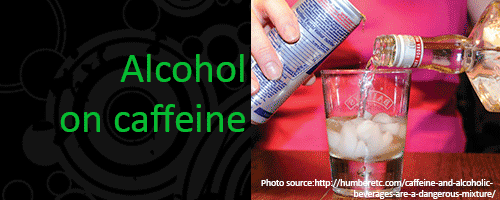Let’s be honest, some days you want to go out and party with friends but you’re too exhausted. Your quick fix? A sweet drink, caffeine, and booze, right? WRONG! One often overlooked area of drinking is the combination of caffeine and alcohol.
You’re probably thinking, “No, way! They cancel each other out”. Well, according to Dr. Steven Lipshultz, chief of pediatrics at the University of Miami medical school:
“As a stimulant, caffeine jazzes up your whole body, increasing blood pressure, heart rate and, in some cases, causing heart palpitations and an irregular heartbeat. Caffeine also leads to headaches, jitteriness, agitation, stomach problems and abnormal breathing. It’s the equivalent of an adrenaline rush… Alcohol, on the other hand, is a depressant that slows the brain’s functioning and impairs one’s ability to walk, talk and think clearly. Mixed, the stimulant and the depressant do not cancel each other out….Instead, the caffeine appears to override the natural sleepiness that occurs when someone drinks alcohol. It also delays the feeling of drunkenness, so those who drink an alcoholic energy drink are likely to keep drinking beyond their normal limits.”
This is especially dangerous for inexperienced drinkers and smaller individuals (<130 lbs.). Teens and college students are especially at risk as they are often inexperienced drinkers and “more slender than older drinkers,” which can increase the negative impact of binge drinking.
Dangers of Mixing Alcohol and Energy Drinks:
- Energy drinks are very popular among young people and are regularly consumed by 31% of 12- to 17-year-olds and 34% of 18- to 24-year-olds.
- When alcoholic beverages are mixed with energy drinks, the caffeine in these drinks can mask the depressant effects of alcohol. At the same time, caffeine has no effect on the metabolism of alcohol by the liver and thus does not reduce breath alcohol concentrations or reduce the risk of alcohol-attributable harms.
- Drinkers who consume alcohol mixed with energy drinks are 3 times more likely to binge drink (based on breath alcohol levels) than drinkers who do not report mixing alcohol with energy drinks.
- Drinkers who consume alcohol with energy drinks are about twice as likely as drinkers who do not report mixing alcohol with energy drinks to report being taken advantage of sexually, to report taking advantage of someone else sexually, and to report riding with a driver who was under the influence of alcohol.
What to do about it?
- Eat high protein foods before you start drinking. This will help slow down the alcohol absorption rate into your body.
- Know what your limit and what you are drinking. Be aware of the drinks you are consuming and how it will affect your body.
- Take breaks! Alcoholic beverages with caffeine can be deceiving because the caffeine masks the depressant effects of alcohol. Alternate drinks between alcohol and non-alcoholic drinks.
- Always plan ahead, get a DUDE or a safe ride home!
References:
- http://articles.orlandosentinel.com/2010-11-18/business/os-caffeine-alcohol-mix-20101118_1_alcoholic-energy-drink-alcohol-and-caffeine-older-drinkers
- http://www.cdc.gov/alcohol/fact-sheets/caffeine-and-alcohol.htm
